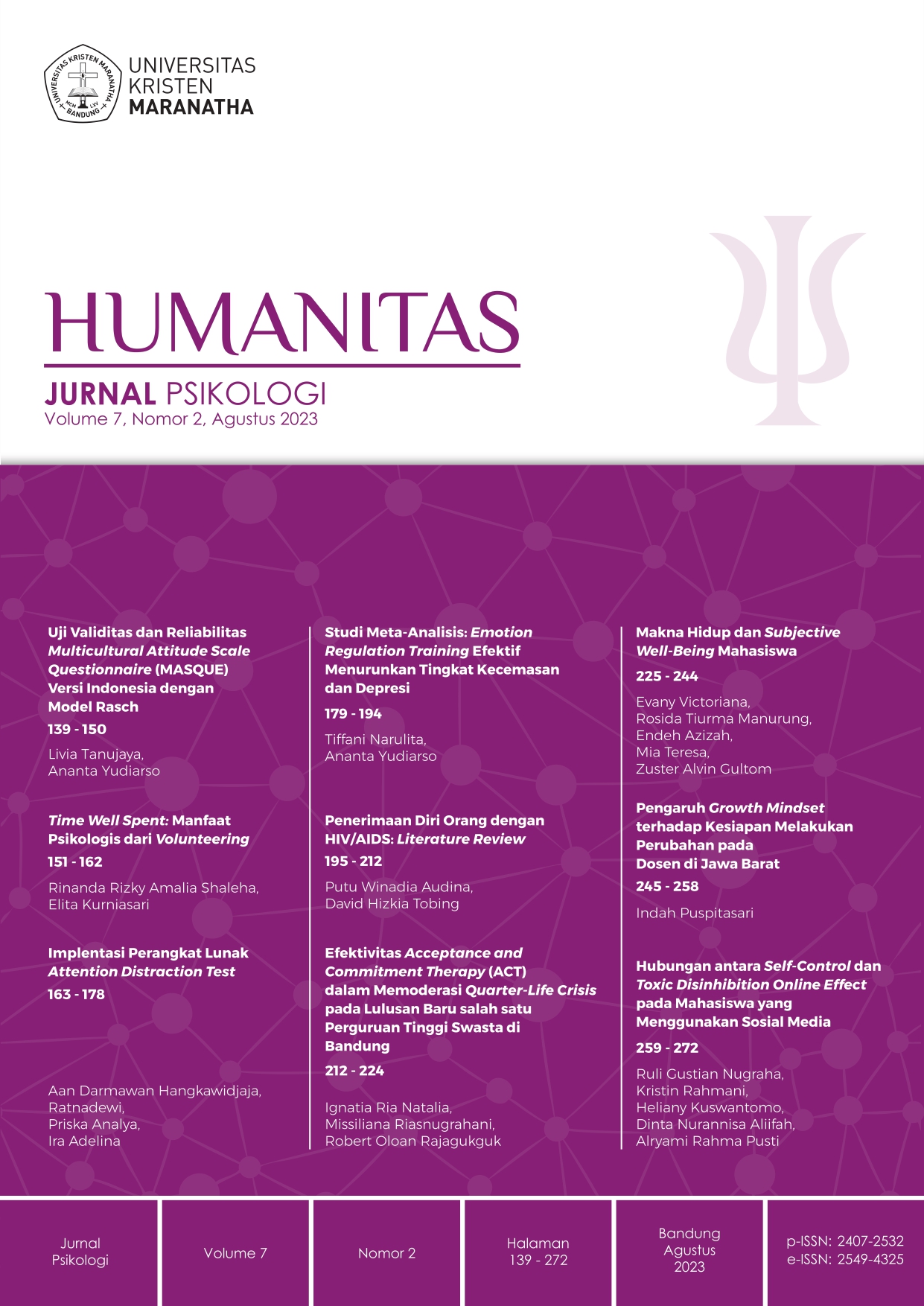Hubungan antara Self-Control dan Toxic Disinhibition Online Effect pada Mahasiswa yang Menggunakan Sosial Media
Isi Artikel Utama
Abstrak
Unduhan
Rincian Artikel

Artikel ini berlisensi Creative Commons Attribution-NonCommercial 4.0 International License.
Referensi
Asosiasi Penyelenggara Jasa Internet Indonesia. (2016). Survey Pengguna Internet Indonesia. Jakarta: APJII.
Azwar, S. (2012). Reliabilitas dan Validitas. Yogyakarta: Pustaka Pelajar.
Baron, Robert A., & Branscombe, Nyla R. (2012). Social Psychology – Thirteenth Edition. USA: Pearson Education, Inc.
Baumeister, Vohs, & Tice. (2007). The Strength Model of Self-control. Psychological Science. SAGE Publications.
Berzonsky. (1986). Moral Development Child Development. USA: The MacMillan Psychology Reference Series.
Bhandari, P. (2021, 7 Juli). Pengantar Penelitian Korelasi. Juru Tulis.
Brooks, M. (2009). The Online Disinhibition Effect and Its Impact on E-Learning Environment. Library Faculty Research Paper 9.
Burns, R. B. (1993). Konsep Diri: Teori Pengukuran, Perkembangan, dan Perilaku. Jakarta: Arcan.
Chaplin, J.P. (1995). Kamus Lengkap Psikologi. Jakarta: PT. Raja Grafindo.
Edwina, I. P., & Handayani, V. (2014). Pengantar Psikologi Perkembangan. Bandung: Maranatha University Press.
Farel, Vella, & Mira (2023). Pengaruh Konrtol Diri terhadap Perilaku Disinhibition Online Effect di Komunitas Remaja Gereja Santo Nikodemus Ciputat. Jurnal Psikologi, Filsafat dan Saintek. Vol. 2 No. 2, 106-113.
Fisher, B. A. (1986). Teori-teori Komunikasi. Bandung: Remaja Rosdakarya.
Gackenbach, J. (2007). Psychology, and The Internet: Interpersonal, Interpersonal and Transpersonal Implications. San Diego: Academic Press.
Hardy, M. & Heyes, S. (1998). Pengantar Psikologi. Jakarta: Erlangga.
We Are Social and Hootsuite. (2017). Digital in 2017 Global Overview. New York: We Are Social Ltd.
Joinson, A. N. (2001). Self-Disclosure in Computer-Mediated Communication: The Role of Self-Awareness and Visual Anonymity. European Journal of Social Psychology, 31, 177-192.
Johnson, S. (2003). Emergence: The Connected Lives of Ant, Cities, and Software. New York: Simon & Schuster.
Lapidot, L., & Barak, A. (2012). Effect of Anonymity, Invisibility, and Lack of Eye-contact on Toxic Online Disinhibition. Computers in Human Behavior, 28, 434-443. The University of Haifa.
Myers, G.E., & Myers, M.T. (1992). The Dynamic of Human Communication: A Laboratory Approach. Sixth edition. New York: McGraw-Hill, Inc.
Rakhmat, J. (2005). Psikologi Komunikasi. Bandung: Remaja Rosdakarya.
Santrock, J.W. (2012). Life-span Development. 13th Edition. University of Texas, Dallas: McGraw-Hill.
Straus, N. (1997). The Fourth Blow to Narcissism and The Internet. Literature and Psychology, 43, 96-109.
Suler, J. (2004). The Online Disinhibition Effect. Cyberpsychology & Behavior, 7(3), Mary Ann Liebert Inc.
Tuhumena, H.A.B. (2006). Upaya Membentuk Konsep Diri yang Positif dalam Rangka Menurunkan Kecenderungan Berperilaku Agresif Pada Remaja. Jurnal Psikologi, 17(1).

